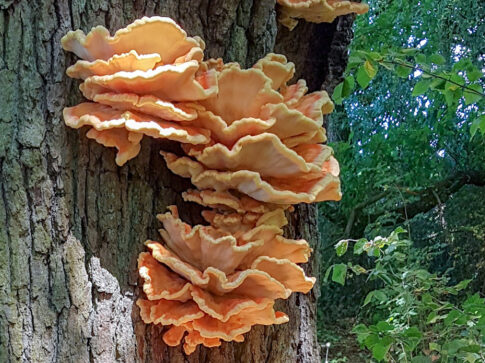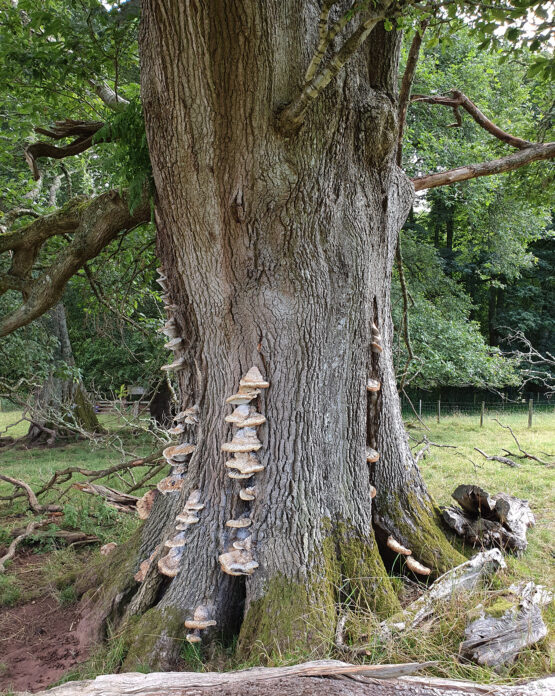Help us to deepen our understanding of our majestic British oak trees and the fascinating fungi that shape their lives.
Welcome to our community science project that aims to gather fungi and tree observation data through our mobile apps!
Download the mobile app and the project guidebook
You can find everything that you need to get started with making records in the links below.
There are now two versions of the survey available:
Our original survey allows for multiple fungus observations to be logged for each tree. It requires detailed observations of the trees condition and takes between 5 and 15 minutes per survey submission.
Our new ‘Lite’ version of the survey can be used for submitting single fungus observations with GPS position and tree measurements, with minimal additional information required. This version is quicker and simpled to use and still provides us with useful data!
Both versions of the survey can be downloaded into the Survey123 app, so you can choose which to use based on your observations or the amount of time that you can spare.
Read the installation instructions in the guidebook carefully before installing!
You can obtain a unique collector code so that we can identify which records are yours, but you’re welcome to submit anonymous records.

The project
The oaks must be amongst the UK’s most loved trees. Their tangled branches and grand stature have inspired countless folk tales and they are an iconic part of the British landscape. Oaks are the third most common tree in woodlands and the most common in openly grown settings, totalling more than 120 million individuals. They can live to over 1000 years and the UK supports more than 49,000 ancient, veteran, and notable oak trees, more than all other European countries combined.
As with all trees, fungi play many essential and formative roles in an oak’s life. These range from mycorrhizal associations that provide critical nutrients throughout their lives, through to the heart-rot fungi that engineer the great hollows that support a rich multitude of biodiversity.
Despite a great history of research and observation, much like the empty mysterious darkness that an oak hollow emits, there are many gaps in our knowledge of the fungi that grow on and with oaks, their interactions, and their effects on the life of tree. Through this community science project, utilising a mobile app, we hope to encourage those of you that have a love and knowledge of oaks, and the fungi that inhabit them, to assist us by making and recording observations.
The project is launching in the autumn of 2020 and is intended to run until 2023, providing us with an up to date snapshot of the status of oak associated fungi and the trees themselves. The large amount of potential data that we hope will be kindly provided by the community would take an impossible amount of time for a small research team to acquire. So, your contribution can really make a difference to this research and our knowledge of these fantastic trees and their fungi.
This website is intended as a guide and reference for those contributing to this project, covering how to use the app, background information and pointers on identification of some of the key species of fungi found on oak.


Oak tree biodiversity
Oak trees support a phenomenal diversity of organisms, over 2,300 species not including all the fungi and other microbes. This includes birds, bats, bryophytes, lichens, mammals, and a huge number of invertebrates. Around 320 of these species are endemic to oak and a further 229 are rarely found on any other trees.
The larger currently known portion of these oak associates is made up of invertebrates, and a majority of these interact with the fungi in the tree in some way. Many make their homes and find their food where heart-rot decay fungi have been in action, leaving partially decayed material that is physically broken down by insects, creating mounds of composting wood mulch that creates further habitat for other invertebrates. Some ambrosia and bark beetles bring symbiotic fungi into the oak tree with them in specially adapted ‘pockets’ on their bodies, called mycangia. Once they have burrowed under the bark, these beetles deploy the fungus where it starts to grow and decompose wood, creating a food source that the beetle then harvests, leaving patterns of adjoining corridors.
The biodiversity that the fungal decay of oak supports goes beyond these saproxylic invertebrates. The hollows that are created by brown and white rot fungi become homes to many insects such as bees and ants, but also to a host of small mammals, bats and birds that make their roosts and nests in these dark crevices.
It is this amazing engineering partnership, between tree and fungus that creates this incredibly rich habitat, and we hope that this survey and your contributions will go some way towards a better understanding of this process and the fungi involved.
Who can get involved?
This community science project is aimed at anyone with a knowledge of trees and the fungi that inhabit them. We openly encourage anyone who can tell a chicken-of-the-woods from a beefsteak to get involved. All we ask is that you are very careful in your identification before submitting a record. The only other requirements are to be able to access oak trees, which can be found everywhere in urban, rural, and woodland settings, and to have access to a mobile device or computer and camera.
The identification of fungi is a skill that requires time to develop and this may be a limiting factor for some who wish to be involved. In an attempt to encourage those less confident to use the app we have set two levels, a simple mode with photographs and a small selection of common or easily identifiable fungi, and an expert mode that is built around a list of all known oak associate species. We have included a guide to the field identification of key oak species later in this document. You can also get help with your identification from the British Mycological Society’s Facebook group or the project’s group page.
There are plenty of technical terms for the features that can be observed on oak trees, many that may be new to field mycologists, less so to arboriculturists. For each section we have provided images in the app and a more detailed reference later in this guide. If at any stage you are unsure about a feature, please look it up or visit our Facebook group to get support from the community.
Learning to use the app with confidence and how to submit good records will take a few surveys submissions. We hope that we have made the app self-explanatory and for those parts that require additional assistance this guidebook will offer the answers.
We hope that being involved with this project will be rewarding and enlightening, bringing you closer to our majestic oaks and the weird and wonderful fungi that inhabit them.


What does the survey hope to achieve?
The data that we will be gathering has the potential to give insights into many questions surrounding oaks and their fungi. By comparing with historical record data, we hope to be able to give an up to date picture of the distribution of different fungal species and how this may have changed over time. The data will also provide a baseline for future studies.
Along with this distribution data, we will also be aiming to answer some of the following questions:
- Which species of fungi are observed on oak trees surveyed between 2020 and 2023?
- Does the age of the tree influence the likelihood of presence of different species?
- Where and when are decay fungi fruiting on oak?
- Are there any clear geographical variations or zones of species dominance or absence?
- Are any species changing their expected range?
- Does altitude effect species presence?
- Does the presence of one species reduce or increase the chance of the presence of other species within a locality?
- Are certain species more likely to be associated with a type of entry/exit point?
- What is the variation in height of fruiting in each species?
- Are trees which have undergone forms of human management (pollarding, coppicing etc) more likely to have observable fungal fruit bodies present?
- Are certain species associated with the human management of trees or with non-managed trees?
There are likely many more questions that we may be able to address with this data set. We will be monitoring and exploring the data throughout the 3-year period and will use our findings to shape new lines of enquiry and potentially make alterations to the app if needed.
Alongside the scientific output of this project we hope to bring people closer to these remarkable trees and their fungal allies, and to raise awareness of their importance. We hope that everyone involved will learn new things and that the outputs will go on to help with protecting these amazing organisms.






